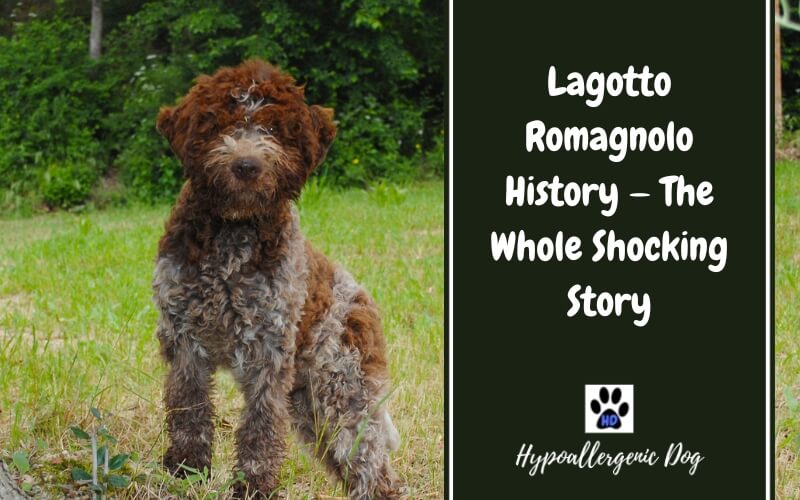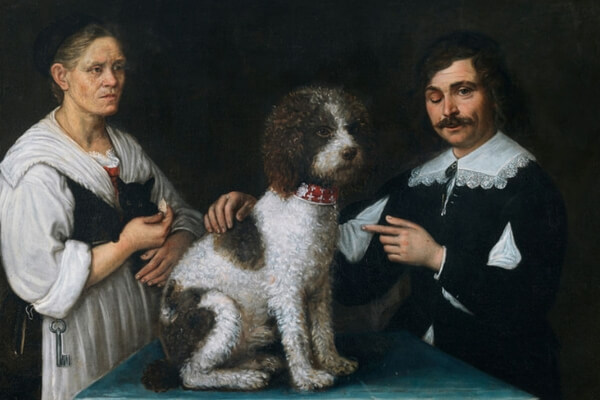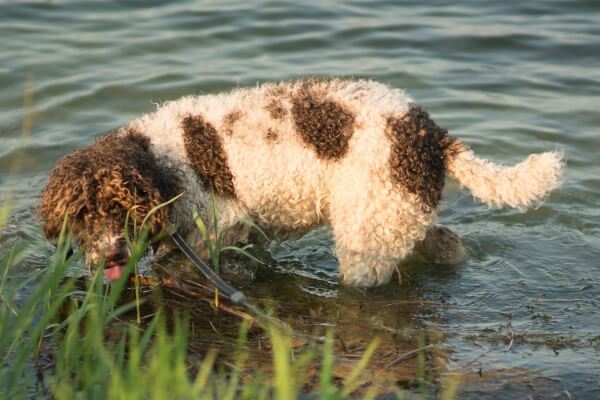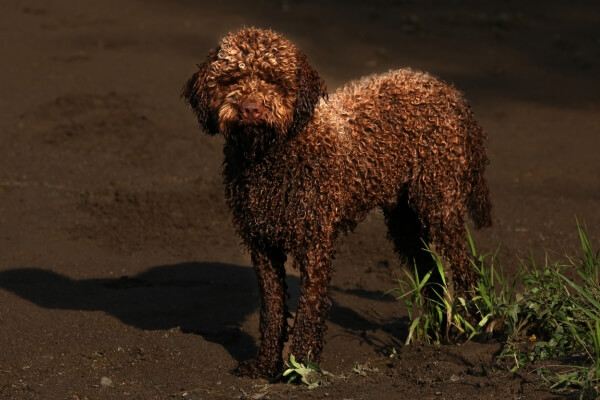Lagotto Romagnolo History — The Dog That Wouldn’t Die
With a backstory featuring passionate Italians, wild animal hunting, near extinction, and one of the most valuable treasures in the world — Lagotto Romagnolo history reads like a 19th Century novel.
Yet, emerging from this flamboyant, noble, and dramatic background emerges a phenomenal purebred dog that today captivates people around the world.
This is the incredible — and 100 percent true — story of the Lagotto Romagnolo.
The History of the Lagotto Romagnolo
Naked Bodies
For the last 2000 years, the Italians (or Romans for many of those years) — have been obsessed with art.
Renowned for their passion and joie de vivre — or whatever the Italian equivalent is — they knocked out paintings, sculptures, frescos, murals, and literature as if their life depended on it.
However, while they had the versatility to have their fingers in all the available artistic pies — their choice of subjects was limited. They painted representations of Greek and Roman Gods (usually depicted naked), religious stories (semi-naked angels and harlots), chubby women (always naked), and Classical architecture (naked people on marble steps, usually reading a book).
But, what they were less keen on depicting were dogs — probably because they couldn’t paint them naked.
Representations of the Lagotto Dog Breed in Art
So, while today we have a more than intimate knowledge of the Italian historical perspective on deities, beauty, and the naked form, we know little about their attitude towards canines.
As experienced Lagotto breeder Ray Sharpe explains,
‘Italians weren’t really good at documenting anything to do with dogs. We’ve got verbal stories of Lagottos, they go back to the fourth century. Written history, we go back to the 12th century. And, they’re depicted in the 14th century. But, there isn’t a mass of evidence.’
And Ray is correct. To be fair, there is some art history of the Italian Lagotto dog, just not much. For example, in 1591, the poetic Erasmus of Valvasone wrote about the Lagotto:
‘A rough and curly-haired breed of dog that does not fear sun, ice, or water…that climbs mountains, fords rivers, and runs onto steep rocky places. Its head and hair resemble that of a ram, and it brings the bird back to the hunter merrily.’
Furthermore, check out this painting:
This oil on canvas by Paolo Barbieri (1603-1649) clearly depicts a Lagotto. And, it’s obvious that the artist knew he was being a complete maverick by painting a dog — instead of a pair of breasts or gentleman’s parts.
First, he called the image, Portrait of Guercino and His Mother With a Lagotto — just in case contemporary Italians were unsure what the furry thing in the middle of the picture was.
Second, in a complete break from Italian tradition, no one is naked — he could easily have given in to peer pressure and exposed Guercino’s mother’s right breast.
Finally, and perhaps most tellingly, notice Guercino’s massive finger pointing at the dog while he winks at the viewer with his right eye, as if saying, ‘Yeah, I know! Seriously! Look at that! It’s a dog in an Italian painting!’*
*To be fair, art scholars explain that Guercino is not, in fact, winking. Instead, he had a right-eye deformity from birth, which led to his nickname of ‘Guercino’ (his name was actually Giovanni) — which means ‘little cross-eyed fellow’. That’s the truth. And somehow worse than my winking theory. Kids can be cruel.
Duck Diving Lagotto Dog
While the artistically-elite were living it up in Rome painting, sculpting, and writing — some Italian guys were actually doing some work.
In the Ravenna marshlands and Comacchio lowlands, the local Lagotti (marshmen) were outside in all weathers — hunting ducks on the unforgiving and dangerous terrain of bogs and swamps. And, joining these down-to-earth laborers in their travails was the Lagotto Romagnolo — meaning the duck-dog of Romagna.
The Lagotti marshmen were hard workers, but they were not superheroes. Their Lagotto dogs, however, were.
These resilient and determined animals would retrieve the shot ducks for hour after hour — even breaking through solid ice, diving to collect the fallen birds, and then bringing them back to their handler. Benefitting from their lanolin-protected and moisture-resistant curly coat — they remained warm and relatively dry during their hours of work.
Many people consider that the Lagotto was the original water dog — preceding the Portuguese Water Dog, Standard Poodle, and Irish Water Spaniel. So, if anyone ever asks you what is the oldest breed of water dog — you know the answer.
Anyways, this incredible symbiosis of marshman and Italian water dog continued for almost 300 years — until disaster struck.
Unemployed Romagnolo Lagotto
The Lagotto Romagnolo dog took to bird retrieval like a duck to water. But, the water disappeared — and consequently, so did the ducks.
Depending on what 19th-century history you read — yes, they even had alternative facts back in the 1800s — the marshlands either dried up naturally or were drained.
According to some, it was just natural climate change — or more likely, the truth that farmers reclaimed the land for agricultural crops. Basically, a trend that was already happening both in the Netherlands and the east coast of England.
What is, however, agreed upon is that this drying up happened between 1840-90.
This meant that the Lagotti marshmen and their Italian hunting dog companions would soon find themselves unemployed. But, these hard-working humans and canines were not shirkers who would give up and make their way to the Social Security Office for handouts.
The Lagotti already knew their dogs were fairly efficient truffle locators, but they considered this skill more of a novelty than a source of income. However, faced with slowly seeing their watery marshlands disappear, they knew the duck days would eventually end — so gradually moved into commercial truffle hunting with their Lagottos.
The Lagotto Becomes the Italian Truffle Dog
Naturally, this didn’t happen overnight.
Sure, the Italian dog Lagotto Romagnolo was fairly good at hunting truffles, but it had been raised since birth as a duck retriever. And, while you might, at a push, be able to teach an old dog new tricks — a complete career change is something of a challenge.
So, the marshmen — who also doubled up as Lagotto Romagnolo breeders — began to train the dogs from puppies as truffle locators.
The dog’s intelligence, desire to learn, incredible sense of smell, and love of searching meant it excelled at this task. Furthermore, its tightly-knitted, curly coat and stocky build allowed it to drive through gorse, bush, and thorny woodland scrub.
By the 1920s, the Lagotto Romagnolo was famous throughout the Valle del Lamone, Valle del Senio, Valle di Santerno, and Romagnolo Apennines as the ultimate truffle hunter.
And today, as Lagotto-breedering maestro Ray Sharpe points out, the dog is famed around the world as the supreme truffling dog.
‘So now, Lagottos are the only registered truffle hunters in the world. You can get anything that can hunt for truffles — pigs, flies, birds, or whatever — but, this is the only dog whose sole purpose is to hunt truffles. In Europe, when they’re fully truffle trained, you can sell them for anything between 10 to 15k euros — they’re worth a lot of money.’
Oh, yeah. I nearly forgot to mention.
Between the 1920s and the present day — the dog almost disappeared off the face of the earth.
Almost as Dead as a Dodo
Crossbreeding
The Lagotti were not dog breeders with any allegiance or membership of any particular kennel club, nor owners that would perm, bleach, and fluff-up their Lagottos for pretentious dog shows.
They were simply hard-working guys with equally industrious dogs trying to earn a living with their canines.
The Lagotti didn’t care, nor had any particular notion of homogeneity or purebreds — they just wanted a dog that could hunt truffles effectively. This meant that, if they thought their dogs could be made more efficient hunters through crossbreeding, they would do it.
While from the marshmen’s point of view, this was a justifiable course of action — it decimated the breed. Decades of crossbreeding meant that, by the 1970s, the purebred Lagotto had virtually disappeared.
Thankfully, in 1975, some Romagna-dwelling dog aficionados decided to take action.
Dinosaurs
Quintino Toschi (President of the Romagna Dog Society) appointed himself as leader of the Lagotto resurrection fellowship. He was joined by his loyal deputy, Professor Francesco Ballotta — a man not only an ENCI (Ente Nazionale della Cinofilia Italiana, the Italian Kennel Club) judge, but also so damn old he could remember genuine purebred Lagottos from his youth.
Lagotto breeding supremo Ray Sharpe explains the situation like this,
He (Quintino Toschi) did his research and found that there were only 32 pure Lagottos left. That was it. Just 32. So, he then started a program to rescue the Lagotto.
He looked genetically at all the other breeds that don’t shed — and examined how close they were to the pure Lagotto. So anything that had a ribbon of Lagotto genes he used and mixed into the program to keep the breed going.
Effectively, it was the plot of Jurassic Park — with purebred Lagottos as the extinct dinosaurs, crossed Lagottos as the DNA-donating amphibians, and Quintino Toschi as Richard Attenborough. Some people even say that Michael Crichton based his entire 1990 dino novel on the Lagotto story.*
Anyway, by breeding the remaining purebred Lagottos with close Lagotto crossbreeds, Quintino Toschi brought back the Lagotto Romagnolo from the brink of extinction within 10 years — with today’s modern Lagottos over 99 percent pure. It’s one of the few circumstances where canine cross-breeding has been used for the benefit of dogs — instead of their abuse.
*Ok, no one has ever said this. Well, apart from myself.
The Lagotto Romagnolo Today
Thanks to the hard work and dedication of Toschi, Ballotta — and their as-yet unmentioned sidekicks Lodovico Babini and Dr. Antonio Morsiani — the Lagotto Romagnolo flourished.
Their exploits finally allowed the Lagotto to be recognized by the serious dog authorities:
- 1988 – membership of the ICL (Club Italiano Lagotto, the Italian Lagotto Club).
- 1992 – recognized as a breed by the ENCI (Ente Nazionale della Cinofilia Italiana, the Italian Kennel Club).
- 1995 – recognized as a breed by the FCI (Fédération Cynologique Internationale, the International Federation of Kennel Clubs).
- 2000 – recognized by the Kennel Club (UK).
- 2015 – recognized as a breed by the AKC (American Kennel Club).
Today, there are hundreds of pure Lagottos around the world, with the dog most popular in Switzerland, Germany, France, Holland, Great Britain, Australia, and the USA — and of course, in Italy.
There are brown Lagotto Romagnolo dogs, orange Lagotto Romagnolo dogs, white, off-white, and spotted. All with the genuine DNA of their duck-diving and ice-breaking ancestors. And, hypoallergenic, adventurous, and friendly — they’re the ideal outdoor-loving family companions.
Lagotto Romagnolo history is a rollercoaster of success, disaster, and eventual triumph — testament to the resilience and industry of both the dogs and those determined to save them.







